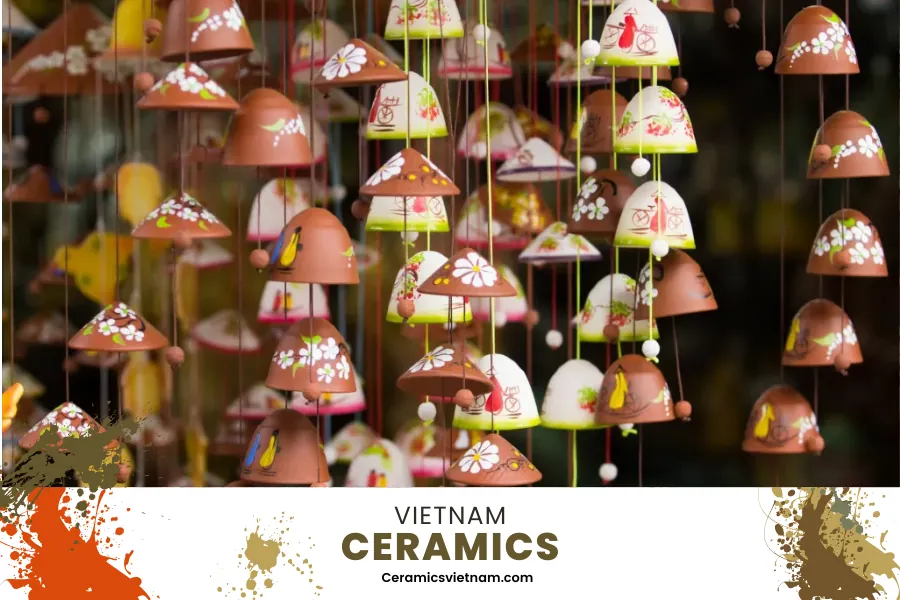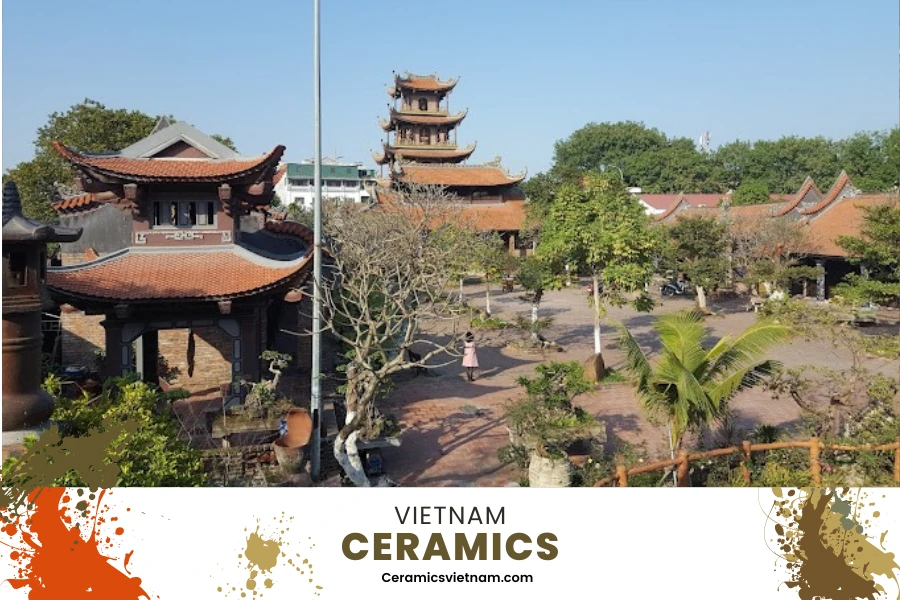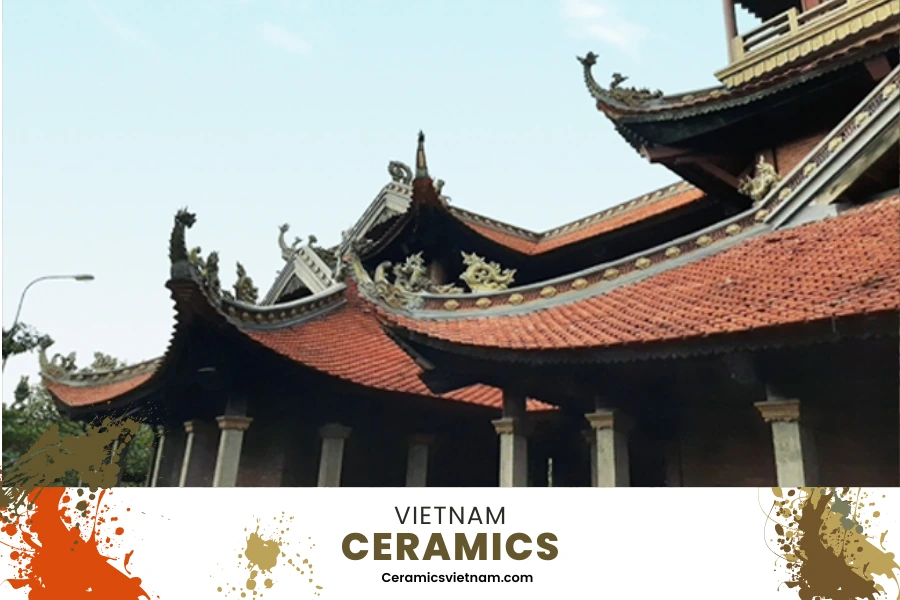Bát Tràng Pottery Village is situated along the Red River, in Gia Lam district, on the outskirts of Hanoi. Not only renowned as a traditional craft village, but it also houses a famous pottery temple. The fusion of ceramic artistry from the cultural heritage of the craft village and the spiritual architecture of Tieu Dao Pagoda has created a unique beauty, preserving the essence of the traditional craft village.
Bát Tràng Pottery Village

Bat Trang Pottery village
Bát Tràng Pottery Village, located on the banks of the Red River in Gia Lam district, on the outskirts of Hanoi, Vietnam, is a renowned traditional craft village with a rich history dating back centuries. This village has gained recognition not only for its exceptional pottery products but also for the unique cultural and spiritual aspects it embodies.
The Red River (also known as Cái River, Cả River, Thao River, Nhị Hà, Nhĩ Hà) is a river with a total length of 1,149 km, originating in Yunnan, China, flowing through Northern Vietnam and flowing into the Gulf of Tonkin. In Vietnam, it stretches for 556 km. This river holds great significance in the cultural landscape of Vietnam, particularly in the context of the country’s wet rice civilization
The village is famous for producing a wide range of high-quality ceramic items, including household goods, decorative pieces, and religious artifacts. Bát Tràng’s pottery is characterized by its intricate designs, vibrant colors, and skilled craftsmanship, making it a sought-after destination for both domestic and international tourists.
One distinctive feature of Bát Tràng is the Tieu Dao Pagoda, a notable spiritual and architectural landmark within the village. This ancient temple has undergone renovations using ceramic tiles, creating a harmonious blend of cultural heritage from the pottery village and spiritual significance. The Tieu Dao Pagoda stands as a testament to the unique fusion of traditional craftsmanship and spiritual expression in Bát Tràng.
Over the years, Bát Tràng has embraced digital transformation in both production and marketing, reaching out to a global audience. The village continues to evolve, with artisans integrating technology to promote and sell their products, ensuring the longevity and relevance of their traditional craft.
With its picturesque setting along the Red River and a rich cultural heritage, Bát Tràng Pottery Village stands as a testament to the enduring legacy of Vietnamese craftsmanship, attracting visitors from far and wide who seek to explore its traditional charm and artistic brilliance.
The distinctive charm of Bát Tràng pottery lies in its meticulous craftsmanship and unique aesthetics. Artisans in this village are known for producing high-quality ceramics, ranging from decorative items to everyday tableware. The pottery is crafted using a combination of traditional techniques passed down through generations and contemporary innovations, resulting in pieces that showcase both authenticity and creativity.
Bát Tràng pottery is often characterized by its delicate hand-painted designs, which frequently depict traditional Vietnamese motifs, landscapes, and folklore. The vibrant colors and intricate patterns make each piece a work of art, reflecting the artisan’s skill and dedication to preserving the cultural essence of their craft.
One of the signature products of Bát Tràng is its ceramic bowls, plates, and vases. These items are not only functional but also serve as exquisite decorations that blend tradition with modern aesthetics. The clay used in Bát Tràng pottery is locally sourced and processed, contributing to the unique texture and durability of the finished products.
In recent years, Bát Tràng pottery has gained international recognition, with its products exported to various countries around the world. The pottery village has also embraced contemporary styles and designs, attracting a diverse audience appreciative of the fusion of traditional craftsmanship and modern sensibilities.
Visitors to Bát Tràng have the opportunity to witness the entire pottery-making process, from shaping the clay to the final glazing and firing stages. The village has become a cultural destination where tourists can not only purchase exquisite ceramics but also gain insight into the rich history and artistic techniques behind this timeless craft. Bát Tràng pottery stands as a testament to the enduring legacy of Vietnamese ceramics, showcasing the skill, artistry, and cultural significance embedded in each meticulously crafted piece.
The ceramic temple – Tieu Dao Pagoda

Tieu Dao Pagoda – The confluence of spirituality and the essence of the pottery village
Bát Tràng Pottery Village consists of two hamlets, namely Giang Cao and Bát Tràng, making it one of the oldest and most renowned pottery villages in Vietnam. The ceramic temple, Tieu Dao Pagoda, is built on the land of Giang Cao hamlet. The temple has a long history, serving as a hiding place for Party documents and newspapers before 1945, as well as a gathering place for many revolutionary activists. Notably, the famous composer Van Cao was actively involved in revolutionary activities here, and his song “Tiến Quân Ca” (Marching Song) was hidden and disseminated from this location.
Throughout various ups and downs and historical events, many structures of the temple have not remained intact. In 2011, when Master Thich Bao Duc became the abbot, he and the Buddhist followers in the village undertook the renovation with the idea of incorporating the essence of the pottery village into the spiritual architecture, creating a unique cultural identity for the temple.
The artisans of Bát Tràng Pottery Village devoted their efforts and talents to create exceptional products, such as the incense burner crafted in the ancient Nguyen style, and worship statues within the temple. From the temple’s roof ridge, horizontal lacquered boards, altar, to the exterior decorative columns, all are made of ceramic tiles.
Remarkably, almost all of the statues inside the Ancestral Hall, Mother Goddess Temple, Eighteen Arhats Temple, and Động Sơn Trang at this temple are also transformed into ceramics by the skilled hands of famous artisans in the village. To date, Tieu Dao Pagoda has recorded 78 statues “ceramified” by the hands of these renowned artisans in the village.
In the main hall of the Tam Bao Pagoda, two Guardian Deities statues are meticulously handcrafted by artisans in the village, cast in solid ceramic with exquisite details. Each statue stands at 2.5 meters tall and took over a year to complete. These are considered “one-of-a-kind” masterpieces highly cherished by the local residents. Additionally, in the Two Halls of Eighteen Arhats, there are 18 statues solemnly placed against a backdrop depicting scenic mountains and clouds, covering a large area.
The exterior landscape of the temple courtyard is also carefully tended to by Master Thich Bao Duc and the Buddhist followers in the village. Every detail of the landscape, from its design to its presentation, is a collaborative effort where the villagers contribute ideas and work together to perfect it.
Mr. Nguyen Van Ky, the Deputy Head of the Temple Construction Committee, who has devoted much passion to the temple’s restoration, shares, “To give the temple its unique features, we, together with the villagers, contributed our intelligence and efforts to infuse the spirit of ceramics into the spiritual essence. It is the dedication of many, the unique pride of Giang Cao village, and the collective pride of Bát Tràng pottery village.”
The successful combination of ceramic artistry from the cultural heritage of the pottery village and the spiritual architecture at Tieu Dao Pagoda brings about a unique beauty and preserves the essence of the traditional craft. It has become a destination for numerous international visitors who come to pay homage to the Buddha and admire the temple’s scenery.
Toward the beginning of spring, the scenery at Chua Tieu Dao remains tranquil

Tieu Dao Pagoda – The confluence of spirituality and the essence of the pottery village
In the early days of spring, the scenery surrounding Chua Tieu Dao, a serene Buddhist temple, comes alive with the vibrant colors of nature. Nestled amidst lush greenery and blossoming flowers, the temple exudes an aura of tranquility and spiritual grace.
As the sun rises, casting a warm golden glow upon the temple grounds, devout worshippers begin to gather for their morning prayers. The air is filled with the soothing melodies of chanting monks, creating a harmonious atmosphere that resonates with the peacefulness of the season. The fragrance of incense wafts through the air, enhancing the spiritual ambiance and inviting a sense of reverence.
Chua Tieu Dao’s architecture reflects a perfect blend of traditional and contemporary elements. Intricate carvings and delicate details adorn the temple’s structures, telling stories of ancient wisdom and spiritual teachings. Visitors are captivated by the intricate design of the pagoda, which stands tall and majestic against the backdrop of blooming cherry blossoms and swaying willow trees.
The temple’s serene gardens are a haven for contemplation and meditation. Stone pathways wind through manicured lawns, leading worshippers and visitors alike to secluded spots where they can reflect in solitude. The gentle sound of a babbling brook adds to the soothing ambiance, creating a meditative environment that encourages introspection and inner peace.
During the Lunar New Year, Chua Tieu Dao becomes a focal point for festive celebrations. The temple courtyard is adorned with vibrant red lanterns, symbolizing good luck and prosperity. Locals and tourists alike partake in traditional ceremonies, wishing for a year filled with happiness, health, and spiritual growth.
As spring unfolds its splendor, Chua Tieu Dao stands as a timeless sanctuary, offering solace to those seeking spiritual enlightenment and a connection to the natural world. The tranquility and beauty of the temple create an enduring impression, making it a place where the divine and the earthly coalesce in perfect harmony














Leave a reply